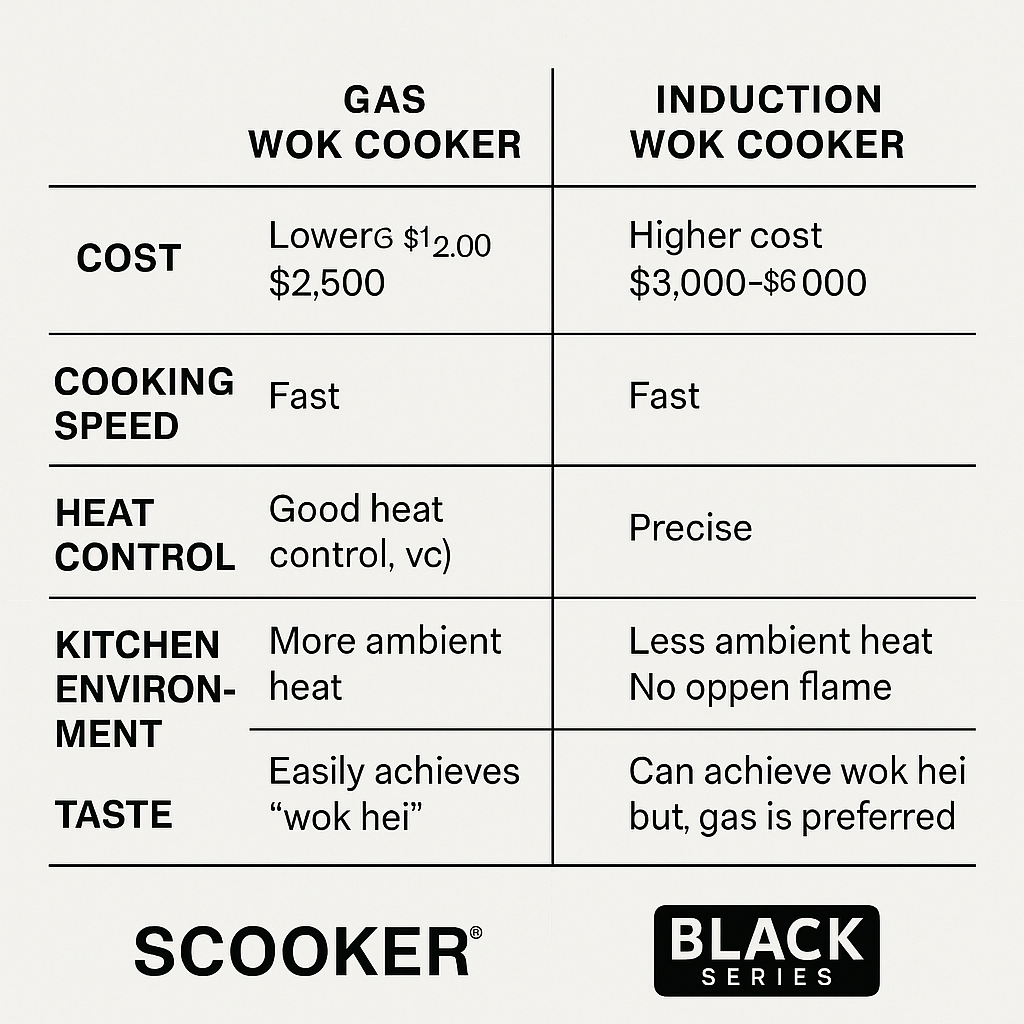In a commercial kitchen, every second counts — especially when you’re stir-frying, wok-tossing, or executing high-heat Asian dishes. The choice between a gas wok burner and an induction wok unit can significantly impact your speed, energy cost, kitchen environment, and even flavour. Today, we compare gas vs induction wok cooking, and highlight models from Scooker and Black Series to help you find the right solution for your operation.
How Gas and Induction Wok Cooking Work
-
Gas wok burners deliver heat via an open flame. They provide direct radiant heat to the wok body and allow chefs to see and adjust flame instantly.
-
Induction wok cookers use electromagnetic fields to heat a compatible wok directly (rather than heating the burner or a flame). The cooktop itself remains relatively cool.
Because induction transfers energy directly to the pan, its thermal efficiency is higher: less energy is lost to the surrounding air. Gas systems tend to lose more heat to ambient air around the pan.
Key Comparisons: Gas vs Induction for Wok Cooking
| Feature | Gas Wok Burner | Induction Wok Cooker |
|---|---|---|
| Speed & responsiveness | Very fast heat-up, direct flame, instant adjustment | Extremely fast heating, nearly instant response on many units |
| Energy / operating cost | Efficiency lower (often 40–60 %); more heat lost to air | High efficiency (70–90 %) because energy is focused on the wok |
| Taste / Wok Hei (flavour) | Classic flame sear, smoky char, the traditional “wok hei” more easily achieved | Modern induction can approximate it in many cases, though some chefs still prefer gas flame for nuance |
| Kitchen environment | More radiant heat, more ambient heat load, plus combustion byproducts | Cooler kitchen, no open flame, safer environment, reduced indoor pollution |
| Cost / capital & installation | Often lower initial cost in existing gas kitchens; gas lines required | Higher capital cost; needs adequate electrical supply (often three-phase) |
| Cookware requirements | Flexible — almost any wok material works | Must be induction-compatible (magnetic stainless steel, cast iron) and good contact with surface |
| Maintenance & cleaning | Flame burners, grates, and burner ports need cleaning; more sooty deposits | Flat surfaces are easier to clean, fewer parts, less sooting and residue |
Brand Spotlight: Scooker and Black Series Induction Woks
Black Series (B+S / Black Induction Woks)
Black Series offers induction wok units designed for professional kitchens. For example, their IN-W1-12-HS single-hole induction wok (12 kW) features a seamless micro-glass top, high-frequency heating coils, multiple power levels, and a stainless-steel frame.
They also offer dual-hole induction wok units like their IN-W2-8 two-hole model (8 kW), suitable for kitchens needing more output.
These units emphasize precise temperature control, ease of maintenance, and improved kitchen safety.
Scooker (Hypothetical / Emerging Brand)
While Black Series is more established in the commercial induction wok niche, Scooker (as a brand to feature) might represent newer or alternative models that compete on efficiency or price. For example, a Scooker induction wok might prioritise “smart” controls, modular design, or cost-effectiveness — though you’ll want to validate specifications like kW rating, build quality, and durability when sourcing.
Cost Considerations & Return on Investment
Capital Cost & Installation
-
Gas wok burners tend to have lower upfront costs if you already have natural gas infrastructure.
-
Commercial induction wok units are more expensive due to advanced electronics, induction coils, and required control systems. For example, Black Series’ induction units command premium pricing given their specifications. Additional electrical upgrades (e.g. wiring, panels, capacity) may be needed, especially for multiple induction units running at high kilowatts.
Operating Cost & Efficiency
Because induction recaptures more energy and delivers it directly to the cookware, it often results in lower ongoing energy costs — especially in modern electricity systems or in environments where fuel costs are high.
In contrast, gas systems lose more heat to ambient air, meaning more waste and less efficient cooking.
Over 3–5 years, the energy savings can offset the higher capital investment — especially in high-use kitchens.
Cooking Speed, Control & Taste
-
Speed: Induction often heats faster than or comparable to gas in many scenarios. In blind tests, induction has achieved faster water boil times across many hobs.
-
Control: Induction gives fine-grained power adjustment, stable temperature hold, and instant responsiveness. Gas offers intuitive flame feedback but less precision in some ranges.
-
Taste: Many chefs argue that gas flame produces superior “wok hei” — that seared, smoky flavour achieved with high heat. However, modern induction wok units (like Black Series) are engineered to approach that level of flavour with proper technique.
In practice, a well-engineered induction wok combined with technique can deliver outstanding results — though for traditionalists, gas still holds appeal.
Which Is Better? It Depends on Your Kitchen
There is no one-size-fits-all answer. The best choice depends on:
-
Existing infrastructure (gas lines, electrical capacity)
-
Volume & frequency of wok cooking
-
Staff skill and preference
-
Long-term energy costs and sustainability goals
-
Budget for upfront investment vs operating costs
If your kitchen already has robust gas, a high-BTU gas wok burner might still be a strong choice. But if you’re building new or upgrading, induction (especially from reliable brands like Black Series) offers long-term efficiency, safety, and cleaner kitchen conditions.
Summary & Recommendation
-
Gas Wok Burners: Excellent for traditional flavour, immediate flame control, lower upfront cost (in gas-equipped kitchens).
-
Induction Wok Units (e.g. Black Series, possibly Scooker): Superior energy efficiency, precise control, easier maintenance, cooler kitchens — though with higher capital and electrical demands.
For high-output kitchens aiming for control, sustainability, and ease of operation, induction is increasingly becoming the future of professional wok cooking. But gas still retains strong relevance — especially for chefs devoted to classic wok technique.










